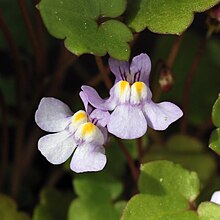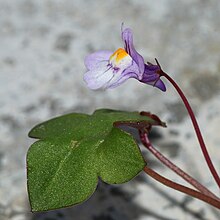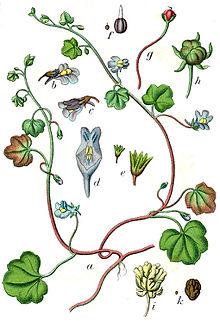Cymbal herb
| Cymbal herb | ||||||||||||
|---|---|---|---|---|---|---|---|---|---|---|---|---|

Cymbal herb ( Cymbalaria muralis ) |
||||||||||||
| Systematics | ||||||||||||
|
||||||||||||
| Scientific name | ||||||||||||
| Cymbalaria muralis | ||||||||||||
| G. Gaertn. , B.Mey. & Scherb. |
The cymbal herb ( Cymbalaria muralis ), also known as cymbal herb , wall cymbal herb or Eustett ( Switzerland ), is a species of plant within the plantain family (Plantaginaceae).
description
Vegetative characteristics
The cinnamon herb is a perennial herbaceous plant . The thread-like, climbing or hanging stems are up to 60 centimeters long. The heart-shaped leaves are mostly reddish in color underneath.
The flower tube is 'masked', closed by a bulge of the lower lip. This excludes weak insects from pollination (power flower). The masking simulates large anthers, a signal to pollen-collecting insects.
Generative characteristics
The relatively small, hermaphrodite flowers are zygomorphic with a double flower envelope . The flower crowns are spurred and mostly light purple.
The flowering period extends from the second half of April to September, the fruit ripening from August to September.
The number of chromosomes is 2n = 14.
ecology
The cymbal herb is a perennial hemicryptophyte or a herbaceous chamaephyte .
From an ecological point of view, these are homogeneous "mask flowers" with a petal spur. The yellow flowers times outside act as on the lower lip of the flower anther dummies. The flowers turn towards the light (they are positive phototropic). Pollinators are bees and hoverflies . Self-pollination also occurs in the flower buds of short side branches that bore into the ground with flowers that remain closed ( Kleistogamy ).
The fruit stalk grows out after fertilization . The small, three-lobed pore capsules spring open and release the seeds . The last seed remains with the fruit firmly connected, the fruit stem grows finally away from light (negative phototrop) and thus, for example, in crevices in. In this way, the seeds are guaranteed to have a cheap germination bed. This makes cymbal herb the classic textbook example of phototropism . The cymbal herb is a self-sower , a dark germer and a horticulturist .
Occurrence
The cymbal herb originally comes from the Mediterranean region . Original locations were rocks in the mountains of northern Italy and the northern Adriatic . The cymbal herb was naturalized ( anointed ) in Central Europe as an ornamental and medicinal plant around the 16th century and is now found all over the world on rocks, but above all in wall cracks (established neophyte ). It prefers warm, but partially shaded to sunny, slightly damp walls and cracks in walls.
According to Ellenberg , it is a half-light plant, a heat pointer, distributed sub-oceanic and preferring locations that are moderately nitrogenous. It is a class of character type of warmth-loving wall-herb communities (Parietarietea, Parietarietalia judaicae). According to Oberdorfer, the species in Central Europe is often a character species of the Cymbalarietum muralis from the Centrantho-Parietarion association.
Botanical history and systematics
This plant species is first mentioned in the herbal books by Lonicer (1582) and Matthiolus (1586), where it is also described as a medicinal plant.
It was first recorded in Central Europe (the Netherlands) in 1644. It is said that she traveled north with sculptures from Italy.
The name 'Zymbalkraut' is first used by Zwinger (1696). The therapeutic areas of application for this plant species varied widely, but the main indications seem to have been wounds, inflammations of various kinds and gynecological diseases. The main ingredients are iridoids.
In the sketch "Linaria cymbalaria", the writer Heinrich Seidel describes how he " anointed " this plant species in Berlin from 1890 onwards .
The valid first publication of Cymbalaria muralis took place in 1800 by Gottfried Gaertner , Bernhard Meyer and Johannes Scherbius . Synonyms for Cymbalaria muralis P.Gaertn., B.Mey. & Scherb. are: Linaria cymbalaria (L.) Mill. , Linaria cymbalaria (L.) Mill. subsp. cymbalaria , Linaria cymbalaria (L.) Mill. var. cymbalaria .
There are about three subspecies:
- Cymbalaria muralis P.Gaertn., B.Mey. & Scherb. subsp. muralis
- Cymbalaria muralis subsp. pubescens (J.Presl) DAWebb (Syn .: Linaria pubescens J.Presl , Cymbalaria pubescens (J.Presl) Cufod. , Linaria pilosa var. pubescens (J.Presl) Bég. ): This endemic occurs only in Sicily .
- Cymbalaria muralis subsp. visianii D.A.Webb : It occurs in Italy and Croatia .
Due to the shape of the flowers, the cymbal herb has long been counted among the figwort family (throat flowers, Scrophulariaceae). After molecular genetic studies and the rules of the ICN ( International Code of Nomenclature for Algae, Fungi and Plants ), it was placed in the plantain family along with many other Scrophulariaceae.
use
The cymbal herb is used as an ornamental plant in parks and gardens on walls and in rock gardens.
Cymbal herb in literature and art
Literature citation
In the cycle of poems, Die Blumen und das Leben , Ludwig Bechstein (1801–1860) writes about the cymbal herb: “Cute plant, you dress the walls of the old ruin, clinging down and up you bloom lonely for yourself. Be the picture of memory, the comrade trusting loneliness, often the sinking castle in the air of past happiness, greened. "
art
In the female portrait “ La Colombine ” by Francesco Melzi , which is now in the Hermitage of Saint Petersburg, you can see a seductive beautiful woman with a bared breast, holding a columbine in her hand . In the background of the picture, cinnabar is entwined along the wall, which is also referred to in the Codex Rinio as umbilicus veneris , i.e. the navel of Venus. From the science of art, the picture is therefore interpreted as a representation of a secret love (" amor nascosto ").
literature
- Axel R. Bretthauer: Isolation and identification of ingredients from Linaria cymbalaria L. Dissertation, Univ. Basel 1991.
- Margot Spohn, Marianne Golte-Bechtle: What is blooming there? The encyclopedia: over 1000 flowering plants from Central Europe. Kosmos, Stuttgart 2005, ISBN 3-440-10326-9 .
- Siegmund Seybold (Ed.): Schmeil-Fitschen. Interactive flora of Germany. Seeing - determining - knowing. The key to the flora . CD-ROM, version 2.0. Quelle & Meyer, Wiebelsheim 2004, ISBN 3-494-01368-3 .
Individual evidence
- ^ Georg August Pritzel , Carl Jessen : The German folk names of plants. New contribution to the German linguistic treasure. Philipp Cohen, Hannover 1882, page 34, online.
- ↑ a b c Stephan Imhof: Linaria cymbalaria - Zymbelkraut - Philipps University of Marburg - Fb. 17 - Biology. Retrieved November 26, 2017 .
- ^ Oskar Sebald, Siegmund Seybold, Georg Philippi, Arno Wörz (eds.): The fern and flowering plants of Baden-Württemberg . tape 5 : Special part (Spermatophyta, subclass Asteridae): Buddlejaceae to Caprifoliaceae . Eugen Ulmer, Stuttgart (Hohenheim) 1996, ISBN 3-8001-3342-3 . , P. 268
- ↑ a b c d Ruprecht Düll , Herfried Kutzelnigg : Pocket dictionary of plants in Germany. A botanical-ecological excursion companion to the most important species . 6th, completely revised edition. Quelle & Meyer, Wiebelsheim 2005, ISBN 3-494-01397-7 , p. 156-157 .
- ↑ a b Erich Oberdorfer : Plant-sociological excursion flora for Germany and neighboring areas . With the collaboration of Angelika Schwabe and Theo Müller. 8th, heavily revised and expanded edition. Eugen Ulmer, Stuttgart (Hohenheim) 2001, ISBN 3-8001-3131-5 , pp. 830 .
- ^ Neophytes in Schleswig-Holstein: problem or enrichment? Documentation of the conference in the LANU on March 31, 2004, publisher: State Office for Nature and the Environment of Schleswig-Holstein, Hamburger Chaussee 25, 24220 Flintbek
- ↑ Heinz Ellenberg : Vegetation of Central Europe with the Alps in an ecological, dynamic and historical perspective (= UTB for science. Large series . Volume 8104 ). 5th, heavily changed and improved edition. Eugen Ulmer, Stuttgart (Hohenheim) 1996, ISBN 3-8252-8104-3 .
- ↑ Adam Lonitzer : Herbal Book . Frankfurt 1582, p. 176.
- ↑ Pietro Andrea Matthiolus : Herbal Book . Nuremberg 1586, p. 395.
- ↑ Theodor Zwinger the Elder : Theatrum botanicum, Newly perfect herb book . Basel 1696, Caput LXXIII.
- ^ Heinrich Seidel: Vorstadtgeschichten 1890 and 1900. Collected works. Volume 2, Stuttgart / Berlin 1925, p. 344 ff.
- ↑ a b c d Karol Marhold, 2011: Scrophulariaceae. : Datasheet Cymbalaria muralis In: Euro + Med Plantbase - the information resource for Euro-Mediterranean plant diversity.
- ^ Cymbalaria in the Germplasm Resources Information Network (GRIN), USDA , ARS , National Genetic Resources Program. National Germplasm Resources Laboratory, Beltsville, Maryland. Retrieved May 10, 2014.
- ^ Latta, Janette APG II Generic changes adopted at RBG Edinburgh. In: Sibbaldia, the Journal of Botanic Garden Horticulture. , Volume 6, 2008, pp. 133-153. PDF
Web links and further literature
- Cymbalaria muralis G. Gaertn., B. Mey. & Scherb., Wall cymbal herb. In: FloraWeb.de.
- Profile and distribution map for Bavaria . In: Botanical Information Hub of Bavaria .
- Cymbal herb . In: BiolFlor, the database of biological-ecological characteristics of the flora of Germany.
- Cymbalaria muralis P. Gaertn. & al. In: Info Flora , the national data and information center for Swiss flora . Retrieved March 4, 2016.
- Thomas Meyer: Cinnamon herb data sheet with identification key and photos at Flora-de: Flora von Deutschland (old name of the website: Flowers in Swabia ).
- Thomas Junghans: On the diasporic spread of Cymbalaria muralis (Scrophulariaceae). TU Braunschweig, 2004, PDF file; 484 kB .
- Thomas Junghans: Investigations into the colonization of walls by Cymbalaria muralis. TU Braunschweig, 2004, PDF file; 36 kB .
- Data sheet with photos from Botanik im Bild / Flora von Österreich , 2006.
- Günther Blaich: data sheet with photos.



